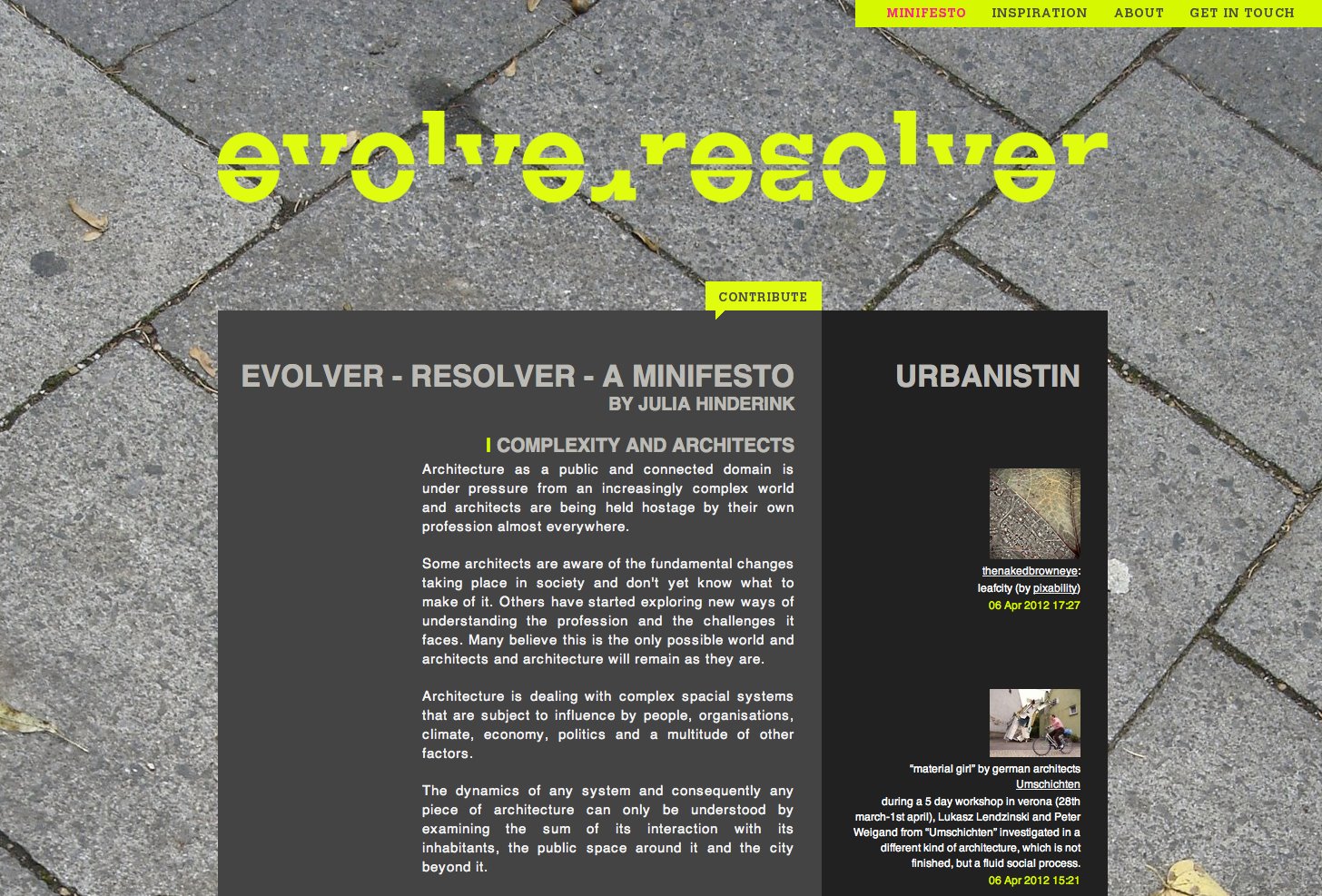
“Evolver - Resolver”
a Minifesto
published on tumblr /Urbanistin January 2012
by Julia Hinderink
I Complexity and Architects
Architecture as a public and connected domain is under pressure from an increasingly complex world and architects are being held hostage by their own profession almost everywhere.
Some architects are aware of the fundamental changes taking place in society and don‘t yet know what to make of it. Others have started exploring new ways of understanding the profession and the challenges it faces. Many believe this is the only possible world and architects and architecture will remain as they are.
Architecture is dealing with complex spacial systems that are subject to influence by people, organisations, climate, economy, politics and a multitude of other factors.
The dynamics of any system and consequently any piece of architecture can only be understood by examining the sum of its interaction with its inhabitants, the public space around it and the city beyond it.
Thus the creations of architects can no longer be seen as mere objects, but must be described as dynamic social systems and as such architects need to approach their design differently.
Architecture must aim to embrace complexity by offering to adapt to changing needs. Adaptability through participation will be the true yardstick.
Conventional expertise as taught and practised today does not cover the knowledge required to channel, examine or include the complex forces existing within spacial systems.
The knowledge that brought architecture to where it is today will not be able to solve the problems arising from that knowledge. It will need a new approach to enter the next level.
II The Art of Listening
Unfortunately the motivation of many of today’s architects in choosing their profession is questionable. Their goal being fame and making grand gestures in high-profile places.
Architects that became architects because of the bling are in trouble: the fame is a little late in coming.
The real “starchitects” are in the minority and in fact do a minor share of architecture in general.
There are still a few “starchitects” designing “blingkrieg” buildings for clients engaging in last and costly attempts to demonstrate their power and wealth through exclusive architecture.
In a very short while, those same clients will look for architects who allow them to make statements inclusive and aware of their intertwined interests with their human and natural environment.
Moreover, many architects often aim first and foremost for a memorable form, disregarding the interaction of the proposed shell with it’s surroundings and inhabitants.
However these inhabitants are no longer as passive as they used to be. They have become accustomed to new power over the corporations and states that often stand behind those buildings.
They have thrown over states and changed the way corporations are operating. Still many architects seem to think they can continue to practice their profession as a means of self expression, amidst a public that has proven to be willing and ready to tear down structures that are much more resilient than brick and mortar.
If architects are to take up their responsibility they must realise that creating architecture is a universal human gift not exclusive to their profession and thus assume the position of a facilitator, harvesting spacial concepts from cooperation.
Instead fundamental research and activities inviting participation in the many aspects of any given architectural task is undervalued, underpaid and consequently neglected. Only if architects get the chance to economically accommodate a shift of focus to open up the research and design phase, can they regain lost social relevance.
Architects need to be freed from an imbalanced understanding of what architecture is about. To avoid getting stuck in the details of implementation and to enable more (paid) time and effort on research and design a division is necessary.
III Two of a Kind
When resources get scarce or the circumstances get complex enough to allow for population in niches, specialisation occurs.
To introduce two names for the different professional orientations within architecture, how about the Evolver and the Resolver.
The Evolver specialises in enabling participation of all stakeholders and identifies, correlates and translates expectations into a conceptional design.
The Resolver specialises in the translation of said conceptional design into a buildable form, the selection of construction methods and materials and the actual construction management.
No Evolver can hope for a successful implementation of his concept without a knowledgeable and prudent Resolver.
No Resolver can hope to create relevant architecture without preparatory work done based on the place and the people by the Evolver, who makes sure the piece of architecture will have positive effects on both.
Of course many architect’s offices already split work into different areas. However, that division of labour is not reflected in architectural education, which does not cover the skills necessary to collect input for the concept from all stakeholders.
Sociology, psychology, anthropology and especially field work with real people in real places must become integral to architectural education. Architects must start listening to the people, get back down to street level, and leave the hierarchical thinking at home. Society dare not tolerate their illegitimate claims to decision making any longer.
Either architects will adapt to the needs of society by specialisation into these branches, or their services will be provided by bordering and new professions.
Just as buildings should remain responsive to change in their urban environments and not become a snapshot of the status quo at the time of their inception, architects have to evolve to become shapers, rather than victims of change brought on by the explosion of complexity.